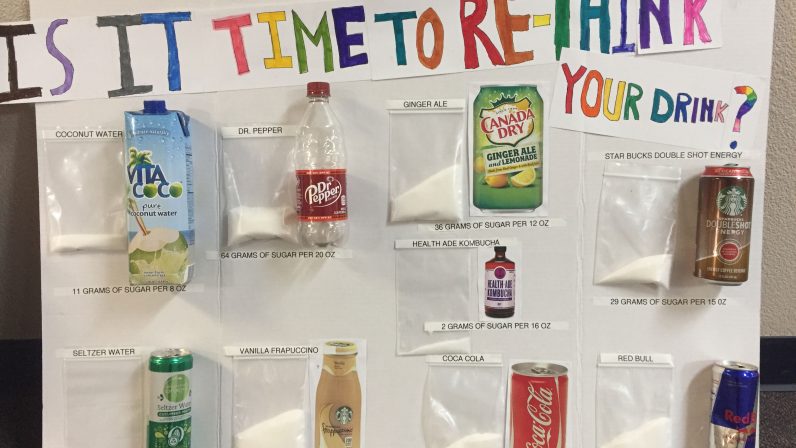written by Lesley Chamberlain, 3rd/4th grade teacher
The kids and I dove, figuratively speaking, into sugar last week. We finished up our (shocking) sugar posters, which present a sort of “in your face” view of the amount of sugar in various drinks on the grocery store shelves today. On each poster, alongside each  bottle and/or label is a carefully measured bag of sugar which corresponds with each serving size. These visuals have been met with wide eyes and dropped jaws.
bottle and/or label is a carefully measured bag of sugar which corresponds with each serving size. These visuals have been met with wide eyes and dropped jaws.
Next on our agenda was continued discussion about sugar and, more specifically, whether or not “healthy” sugars exist. Our class discussion contained the following concepts:
concepts:
- There are two forms of “natural” sweeteners (sugars) and then there are artificial sugars (for our purposes, we left the artificial sweeteners out of our conversations except to say that they have their own health concerns.) Lactoseis found in milk and fructoseis found in fruits.
- Sucrose (a combination of glucose & fructose) is known as “table sugar.” It starts off as sugar cane or sugar beets, and ultimately ends up as refined sugar that if often added to many processed foods.
- What makes fruit and milk sugars “healthier” isn’t necessarily about the sugar itself at all. It’s more about what these foods (milk/fruits) have that unhealthier sweets do not—fiber, protein, calcium, and vitamins including vitamin A, vitamin C, and vitamin D. These are also slower to digest and help keep the body full for longer.
- Refined sugar, in contrast, is broken down much more rapidly. Foods containing such sugar have extra calories and rarely much nutritional value.
- Eating fruit, instead of consuming even 100% fruit juice, is a better choice because of the benefits of its fiber content.
 In addition to some basic sugar information, we also learned how to read nutrition labels and ingredient lists. Students can now use labels to decipher how many grams (1 tsp= approx. 4 grams) are in one serving of their favorite drinks. Students were also appalled when they found out that food manufacturers sometimes use sneaky methods to make their food items appear healthier. One such tactic is known as “splitting sugars.” Since food manufacturers are required to place the most abundant ingredient FIRST in a list of ingredients, manufacturers have gotten smart. In a product with abundant sugar, where sugar might normally be placed high up in the ingredient list, manufacturers may now use a VARIETY of sugars in small amounts. This allows them to legally place these individual smaller amounts toward the END of the ingredient list. The TOTAL amount of sugar in a product may be the same is it always was, but now it has the potential to APPEAR healthier to consumers. Sneaky!
In addition to some basic sugar information, we also learned how to read nutrition labels and ingredient lists. Students can now use labels to decipher how many grams (1 tsp= approx. 4 grams) are in one serving of their favorite drinks. Students were also appalled when they found out that food manufacturers sometimes use sneaky methods to make their food items appear healthier. One such tactic is known as “splitting sugars.” Since food manufacturers are required to place the most abundant ingredient FIRST in a list of ingredients, manufacturers have gotten smart. In a product with abundant sugar, where sugar might normally be placed high up in the ingredient list, manufacturers may now use a VARIETY of sugars in small amounts. This allows them to legally place these individual smaller amounts toward the END of the ingredient list. The TOTAL amount of sugar in a product may be the same is it always was, but now it has the potential to APPEAR healthier to consumers. Sneaky!
The questions from the kids began:
- Why would they even be allowed to “split” sugars? That seems sneaky.
- Why would someone put something into our food that is unhealthy for us?
- Why do they make it so hard to figure out whether something is healthy or unhealthy?
- Why do some labels make a product sound super healthy when it’s really not?
We ended up with many more questions than clear cut answers.
There is hope, however, dear readers. With consistent awareness on their  part, perhaps this younger generation will strive to demand healthier products in the future. It may be a slow process, but remember that big change is rarely swift. I also found it encouraging when my own son, after a cross country meet this week, said, “Mom, this Gatorade tastes better than the other kinds.” My reply was, “You like it better? It’s got half the sugar of the other stuff.” Bit by bit, friends. Bit by bit.
part, perhaps this younger generation will strive to demand healthier products in the future. It may be a slow process, but remember that big change is rarely swift. I also found it encouraging when my own son, after a cross country meet this week, said, “Mom, this Gatorade tastes better than the other kinds.” My reply was, “You like it better? It’s got half the sugar of the other stuff.” Bit by bit, friends. Bit by bit.

